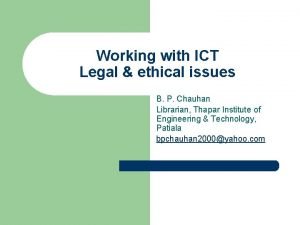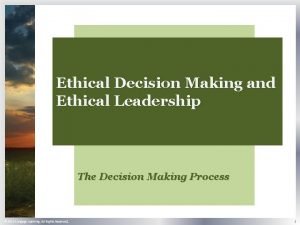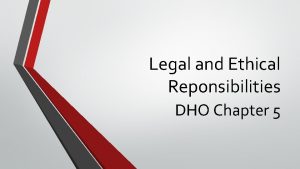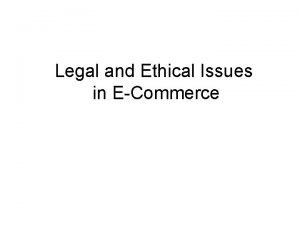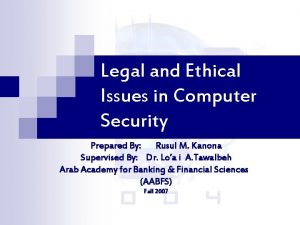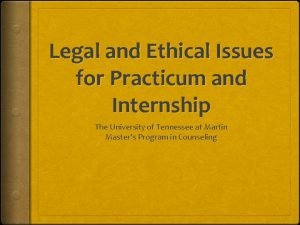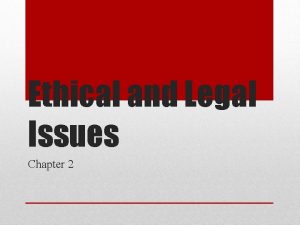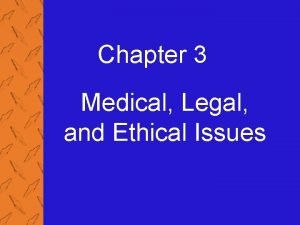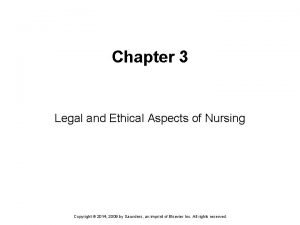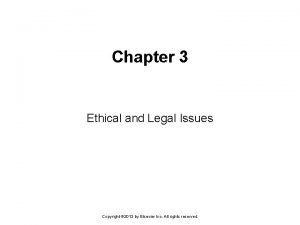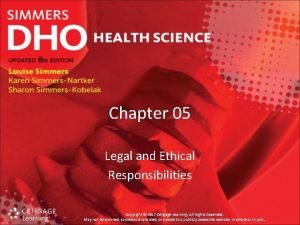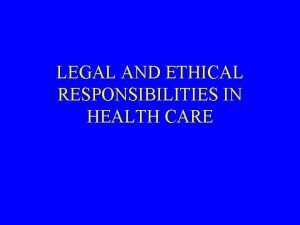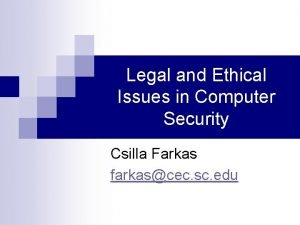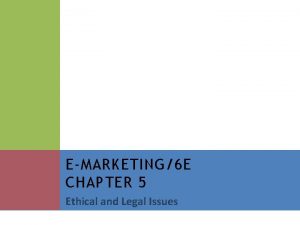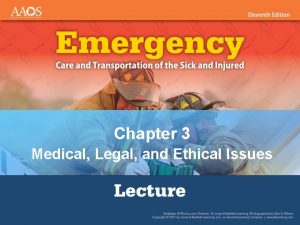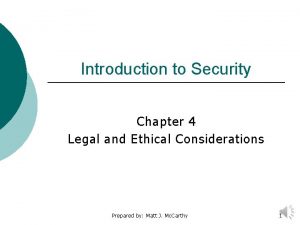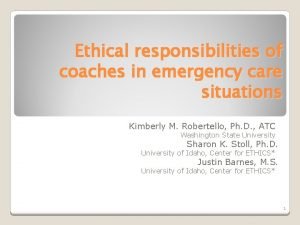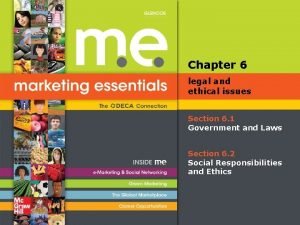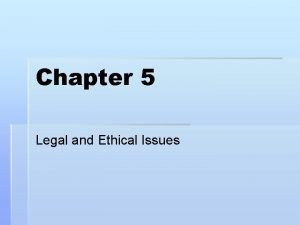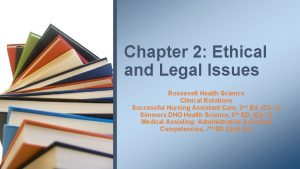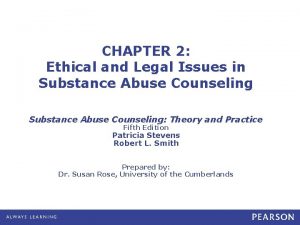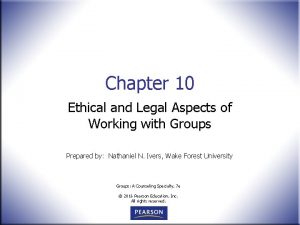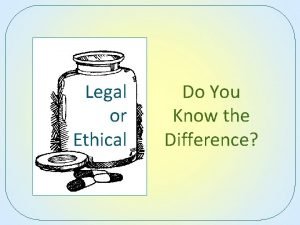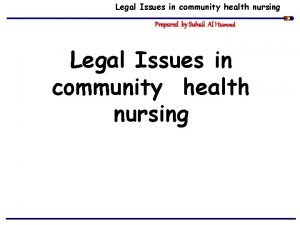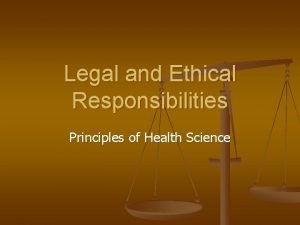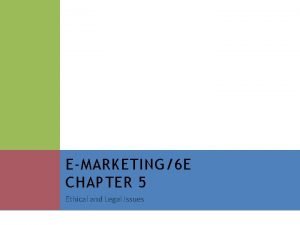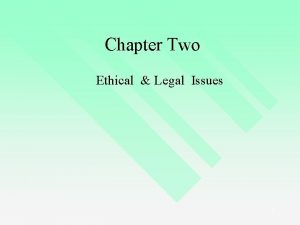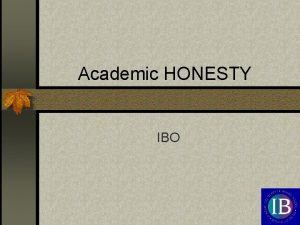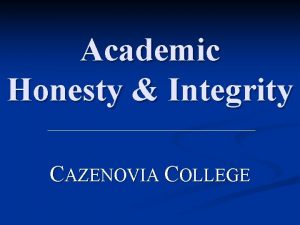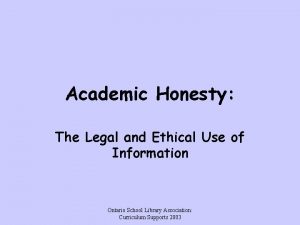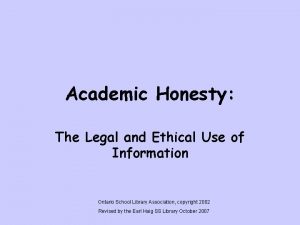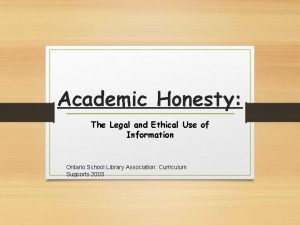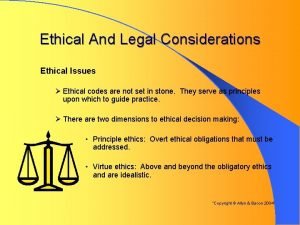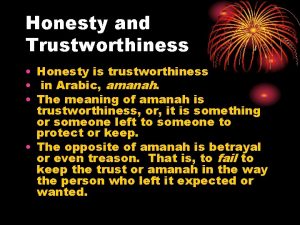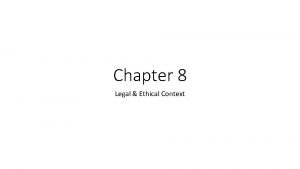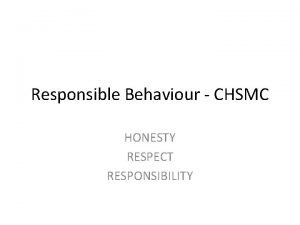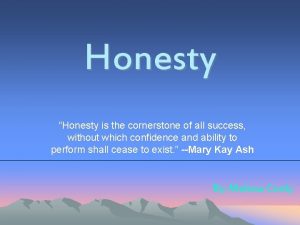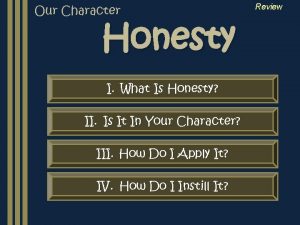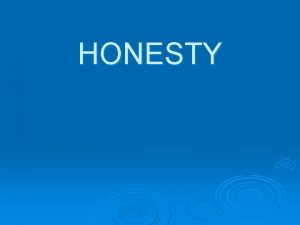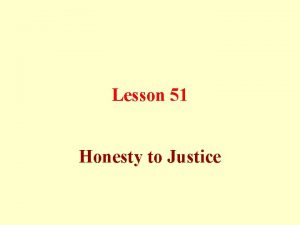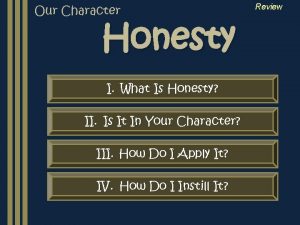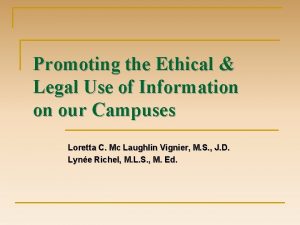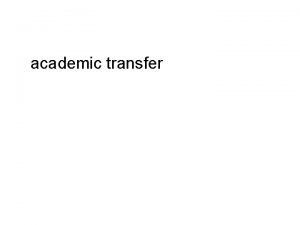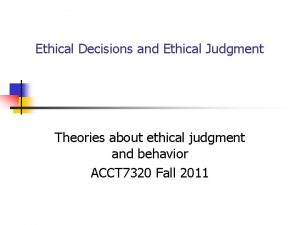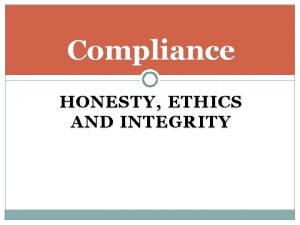Academic Honesty Promoting the Legal and Ethical Use





























- Slides: 29

Academic Honesty Promoting the Legal and Ethical Use of Information by Secondary School Students Ontario School Library Association: Curriculum Supports 2003 1

Academic Honesty: Outline of Presentation 1. 2. 3. 4. What’s the Problem? Plagiarism in a High Tech world (the how and why) Defending against Plagiarism The Best Defense: The Proactive Approach – Rethink the very nature of research assignments and the purpose they serve in the curriculum. – Emphasize the research process and the learning of lifelong information literacy skills. – Structure writing assignments to reduce plagiarism. – Build a common understanding of academic honesty. – Model academic integrity. Ontario School Library Association: Curriculum Supports 2003 2

What’s the problem? In a 2000/2001 American high school study, “ 74% of the respondents admitted to one or more instances of serious test cheating and 72% admitted to serious cheating on written assignments. Over half of the students admitted they have engaged in some level of plagiarism on written assignments using the Internet. ” Center for Academic Integrity Ontario School Library Association: Curriculum Supports 2003 3

What’s the problem? In a 2000 -2001 study of 4, 500 secondary school students, Donald Mc. Cabe found: • 15% have submitted material obtained, in large part, from a web site or internet paper mill • 52% have copied several sentences from a web site without citing the source • 90% of students who plagiarize from the Internet have also plagiarized from written sources Center for Academic Integrity Ontario School Library Association: Curriculum Supports 2003 4

What’s the problem? Plagiarism and other forms of academic dishonesty have always existed. However, today: • Technology has made it so easy to plagiarize. • Academic dishonesty – in its many forms – is a common occurrence. • Plagiarism has become a game of cunning. • The integrity, ethics, and morality of our students are at stake. Ontario School Library Association: Curriculum Supports 2003 5

Plagiarism: Then and Now Old Plagiarism New Plagiarism Students: • copied from books, encyclopedias, journals; Students: • copy from one or more electronic sources; • misrepresented citations or bibliographic entries; • download material from the Internet without acknowledgement; • exchanged or purchased essays. • locate essays in another language and then put them through translation programs. Ontario School Library Association: Curriculum Supports 2003 6

Plagiarism: Then and Now Old Plagiarism New Plagiarism • required time and effort to locate and copy; • copying and pasting is quick and effortless, providing instant gratification; • papers still had to be written or typed; • text fonts can be changed with a simple keystroke; • required personal contact. • requires no personal contact, creating a sense of anonymity. Ontario School Library Association: Curriculum Supports 2003 7

Three Variations of Plagiarism • Unintentional – poorly developed literacy skills and poor understanding of acceptable documentation procedures • Intentional – deliberate attempt to achieve ‘high end’ results with ‘low end’ effort • Invitational – nature and scope of certain types of assignments encourage students to merely “hunt, gather, replicate” (Tom March) Ontario School Library Association: Curriculum Supports 2003 8

Why Students Intentionally Plagiarize • stress of a heavy workload and the competition for high marks • poor time management and planning skills • lack of understanding about concepts and ethics of intellectual property • lack of confidence in their own research and writing skills • project has no meaning for them - they are just “getting it done” Ontario School Library Association: Curriculum Supports 2003 9

The Clues The paper, project or presentation: • is just too good for the student’s level of understanding, knowledge and/or skill; • is consistently better when work is done at home rather than in class; • contains poorly written paragraphs at the beginning and end, and high quality work in between; • sounds familiar; • is suspicious in terms of appearance or topic Ontario School Library Association: Curriculum Supports 2003 10

Become Informed Become informed on cheat sites and different methods of plagiarizing in the high tech world: • Do your own reading concerning high tech forms of academic dishonesty (See Resource List for Teachers) • Investigate Internet sites available to assist educators in preventing and identifying plagiarized work. • Visit electronic paper mill web sites to familiarize yourself with essay retrieval methods. Ontario School Library Association: Curriculum Supports 2003 11

The High Tech Defense • Use a comprehensive search engine (Google, Dogpile, Altavista, alltheweb) to locate possible sources of questionable papers Type in a phrase from the essay or the essay title • Search full-text online subscription databases (EBSCO, Electric Library, Proquest) Type in a phrase from the essay or the essay title This could take hundreds of hours per class assignment • Install filtering software to block out cheat sites This could create a false sense of security, as students can access cheat sites elsewhere Ontario School Library Association: Curriculum Supports 2003 12

The ‘Higher’ Tech Defense Anti-plagiarism programs exist that will compare any paper to those already available on the Internet and will add the paper to a vast database. • Detection services: Turnitin. com (produces a colour coded “originality” report) • Detection services: Glatt Plagiarism Program (has various screening devices) • Detection services: Essay Verification Engine (produces colour coded annotated report) Ontario School Library Association: Curriculum Supports 2003 13

Ontario School Library Association: Curriculum Supports 2003 14

Ontario School Library Association: Curriculum Supports 2003 15

Ontario School Library Association: Curriculum Supports 2003 16

However “Catching Internet cheaters is not the best answer. It’s a lot like doing an autopsy. No matter how terrific the coroner is at determining how or why a person died, the damage has been done. Bringing the culprit to light won’t change that. Preventing the problem is a much better approach. ” Cut and Paste 101: Plagiarism and the Net Ontario School Library Association: Curriculum Supports 2003 17

The Best Defense: Be Proactive 1. Rethink the very nature of research assignments and the purpose they serve in the curriculum. 2. Emphasize the research process and the learning of lifelong information literacy skills. 3. Structure writing assignments to reduce plagiarism. 4. Build a common understanding of academic honesty. 5. Model academic integrity. Ontario School Library Association: Curriculum Supports 2003 18

Research Assignments I Rethink research assignments. Structure them so that they: • • are examples of authentic learning emphasize critical thinking skills emphasize creative thinking emphasize metacognition so that students can think about the “what” and “how” of their learning We CAN structure assignments so they are meaningful and cheat proof Ontario School Library Association: Curriculum Supports 2003 19

Research Assignments II Rethink Traditional Research Products • Focus on time (e. g. write an obituary for a civilization, change a historical decision and predict the possible consequences. • Change format (e. g. debates, simulations, role plays, trials, newspapers, editorials) • Incorporate technology (e. g. TV talk show, Power. Point, web pages) • Create a game (i. e. , with rules similar to Jeopardy, Trivial Pursuit, Survivor) • Create visual products (e. g. dioramas, models) • Create a Webquest Ontario School Library Association: Curriculum Supports 2003 20

Research Assignments III Change Point of View in Traditional Assignments Explain why the French Revolution was inevitable. TO You are a merchant living in Paris in 1790. Explain why you support the French Revolution. Explain and describe the relationship between Anne Frank and her mother. TO Write a letter as Mrs. Frank to Anne, explaining the problems you are having with her. Ontario School Library Association: Curriculum Supports 2003 21

The Research Process I • Identify meaningful steps within the structure of each assignment • Use an assessment scheme giving appropriate weight to process and product • Assess the research process at various stages • Teach students the meaning of plagiarism, intellectual property, and copyright. Ontario School Library Association: Curriculum Supports 2003 22

The Research Process II • Teach students how to use quotations and paraphrasing effectively and how to cite sources correctly. • Require students to submit a research portfolio of notes, sources, and drafts along with their finished product. • Use your school’s Student Research Guide as the standard. Ontario School Library Association: Curriculum Supports 2003 23

Structuring writing assignments to reduce plagiarism I • Evaluate both the research process and the product. • Make sure there is adequate resource material for topics to encourage research success and eliminate student frustration. • Personalize assignments by incorporating an interview, a visit, an opinion component, or an authentic application. Ontario School Library Association: Curriculum Supports 2003 24

Structuring writing assignments to reduce plagiarism II • Monitor a working bibliography as the assignment progresses. • Require an annotated bibliography during the first part of the research process. • Keep samples of student work for comparison. • Require rough notes and drafts to be submitted with final essay. Ontario School Library Association: Curriculum Supports 2003 25

Structuring writing assignments to reduce plagiarism III • Have students do a “metalearning reflection” for major research assignments. In this exercise, students reflect on their personal research experience--what strategies they used, what confused them, what skills they have acquired, how they managed time, etc. Ontario School Library Association: Curriculum Supports 2003 26

Academic Honesty Policies • Use the Academic Honesty Policy, created by some boards as part of their Code of Student Behaviour. • Establish a school-wide policy of Academic Integrity, including consequences for cheating, if a Board policy does not exist. • Apply the policies consistently in your school. Ontario School Library Association: Curriculum Supports 2003 27

Model Academic Integrity Two ways you can model Academic Integrity in the classroom are by: - complying with Canadian copyright regulations when photocopying print materials - showing only videos for which public performance rights have been purchased Ontario School Library Association: Curriculum Supports 2003 28

References Material for this presentation was adapted from the following sources: • Ann Lathrop and Kathleen Foss. Student Cheating and Plagiarism in the Internet Era. • Lisa Renard. “ Cut and Paste 101: Plagiarism and the Net”, Educational Leadership, Dec. 1999/Jan. 2000. • Suzanne Preate. Internet Plagiarism. Syracuse University Library Please refer to the handout “Academic Honesty: a Select Resource List for Teachers” which is an annotated listing of books, journal articles and web sites which can be used as teaching resources. Ontario School Library Association: Curriculum Supports 2003 29
 Legal and ethical issues in use of ict
Legal and ethical issues in use of ict Legal ethical and societal issues
Legal ethical and societal issues Professional issues in cyber security
Professional issues in cyber security Ethical habits
Ethical habits Dho chapter 5 legal and ethical responsibilities
Dho chapter 5 legal and ethical responsibilities Legal and ethical issues in ecommerce
Legal and ethical issues in ecommerce Legal and ethical issues in computer security
Legal and ethical issues in computer security Professional and ethical issues during internship
Professional and ethical issues during internship Ethical and legal issues chapter 2
Ethical and legal issues chapter 2 Chapter 3 medical legal and ethical issues
Chapter 3 medical legal and ethical issues Legal and ethical aspects of nursing chapter 3
Legal and ethical aspects of nursing chapter 3 Legal and ethical issues chapter 3
Legal and ethical issues chapter 3 Ch 5 legal and ethical responsibilities
Ch 5 legal and ethical responsibilities Chapter 5 legal and ethical responsibilities answer key
Chapter 5 legal and ethical responsibilities answer key Attack sophistication vs intruder technical knowledge
Attack sophistication vs intruder technical knowledge Legal and ethical issues chapter 5
Legal and ethical issues chapter 5 Chapter 3 legal and ethical issues
Chapter 3 legal and ethical issues Chapter 4 legal and ethical responsibilities
Chapter 4 legal and ethical responsibilities Legal and ethical responsibilities of a coach
Legal and ethical responsibilities of a coach Chapter 6 legal and ethical issues
Chapter 6 legal and ethical issues Chapter 5 legal and ethical issues
Chapter 5 legal and ethical issues Ethical and legal issues chapter 2
Ethical and legal issues chapter 2 Ethical and legal issues chapter 2
Ethical and legal issues chapter 2 Nonmaleficence
Nonmaleficence Ethical and legal issues affecting the nursing assistant
Ethical and legal issues affecting the nursing assistant What is the difference between ethical and legal issues
What is the difference between ethical and legal issues Legal issues in community health nursing
Legal issues in community health nursing Legal and ethical principles in healthcare
Legal and ethical principles in healthcare Legal and ethical issues chapter 5
Legal and ethical issues chapter 5 Chapter 2 ethical and legal issues
Chapter 2 ethical and legal issues
